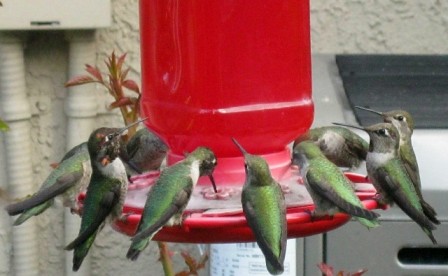Old Ben Courts Wild Birds
The last meeting of the Mission Hills Garden Club’s 2013 summer season was held at the Mission Hills Nursery. Ben Zlotnick, also known as Old Ben, spoke about attracting wild birds. He is an advocate for creating a certified wild life habitat. The entire city of Alpine has such a designation because every household went to the effort of becoming certified.
Birds have many functions in our gardens. They help propagate plants. They eat predators and pests such as aphids. They provide entertainment, and they are a sign that all is well (more or less) in the garden. To create a wild life habitat for birds four elements are necessary: food, water, cover, and a secure nursery for babies.
Providing food can be as simple or as complex as you care to make it. Zlotnick sells bird feeders for various types of birds. Hummingbirds love nectar, but they also eat small insects. Plants, fruits, nuts, and seeds and animals provide sustenance for many birds; providing a species’ preferred food encourages that specie to the feeder. The website www.projectwildbird.org has charts indicating what specific seeds and plants attract which birds. Raptors like small mammals, birds, small reptiles, and fish. However, providing a feeder to attract birds is not necessary, but growing plants that produce the seeds your favorite native birds enjoy will accomplish the same results. For example, hummingbirds love any flower with nectar from fuchsia, snap dragons, columbine, California Redbud to Chuparosa, Salvias and most flowers. Anna’s hummingbird is the most commonly found in our area, and Zlotnick gave us some pointers. These birds can be very territorial, and some are actually bullies. If you put out more than one hummingbird feeder, they must be out of sight of one another. A bully is quite capable of keeping the feeders for him alone; he can actually drive off hummingbird intruders allowing him the luxury of never waiting. Zlotnick has seen other hummingbirds patiently take turns in an orderly fashion. Feeders may be cylindrical or flat, a dish or even a ”sock,” so called because of the shape of a special feeder filled with nitrous nyger seed. Feeders should be securely placed near trees, but keep in mind that squirrels and other creatures may compete for food or eat your hungry birds for dinner.
Water, the second necessary element, can be offered in many ways. Water features attract birds; they also enjoy bird baths. If you have misters, many birds love them. Any body of water which sits must be replaced regularly and its container scoured thoroughly. As a side note, Zlotnick explained that mice do not need water; they get it from their food. However, rats do require water.
Cover is the third element. Shrubs, thickets, brush piles, and even eaves can provide a place for birds to escape the elements and hide from predators. Keeping cats indoors helps keep birds safe, and actually promotes a longer life for the cat. The ideal cover for many birds is a bush or shrub with berries. This is much easier than having to fly around looking for a meal.
Finally, birds need a place to raise their young. Some birds are happy to use a bird house or nest box; others can use whatever they used for cover. Others like the Lesser Goldfinch make their own nests. These are made so tightly, Zlotnick says, that they can even build them in the middle of an Italian cypress. Her nest is so tightly woven that sometimes her babies drown as the nests do not have good drainage. The western Bluebird is a “second cavity nester,” meaning she takes over a nest built by another bird. European Starlings will take over the Bluebird’s home. Zlotnick suggests that a Bluebird nest box with a smaller opening will prevent the European Starling from entering.
Some birds deposit each egg they lay in another’s nest leaving the orphan to be raised by its foster mother. If you do provide a nest box, it needs to be at least four to six feet above the ground.
The nursery must be secure, secluded, and bird houses need trees or parts of a structure for fledglings to use as a resting place if they lose control or lose their nerve on their maiden voyages.
The more native plants you have, the more native species you will attract. However, let beneficial insects and birds keep your pests under control; insecticides kill the good as well as the bad. Furthermore, they poison the soil, the plants, and their seeds. Runoff water picks up these toxins so they eventually are in our water: oceans, rivers, lakes, ponds, and reservoirs.
Category: Events, Local News








